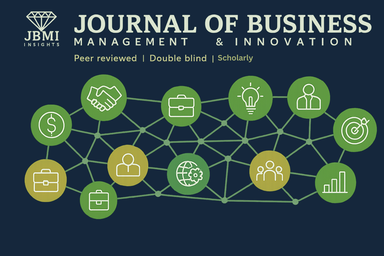Evaluating the Impact of Capital Structure on Firm Performance Across Different Industries in Hamburg, Germany
Abstract
The impact of capital structure on firm performance across different industries in Hamburg reveals that firms with optimized debt-to-equity ratios tend to report stronger financial outcomes, particularly in capital-intensive sectors like manufacturing and logistics. Industries with higher reliance on equity financing, such as technology and services, demonstrate greater flexibility and resilience during economic downturns. Overall, the choice of capital structure significantly influences profitability, risk exposure, and growth trajectories depending on the industry's operational characteristics. The research findings indicate that the impact of capital structure on firm performance in Hamburg is significantly influenced by industry characteristics. In capital-intensive sectors such as logistics and manufacturing, moderate leverage was linked to improved ROA and ROE during stable periods, but increased financial vulnerability during economic downturns. In contrast, industries with high volatility and intangible assets, such as fintech and creative services, showed a negative relationship with debt, favoring equity financing for greater flexibility and resilience. The study concludes that the effectiveness of capital structure on firm performance in Hamburg varies by industry, with capital-intensive sectors benefiting from moderate debt use, while innovation-driven sectors perform better with equity financing due to higher volatility and limited tangible assets. It emphasizes that a one-size-fits-all approach to financing is unsuitable, urging firms to align their capital structure with sector-specific risks, firm size, and local financial system dynamics. The study recommends that firms in Hamburg adopt capital structure strategies tailored to their industry’s operational and financial characteristics, balancing debt use in stable, asset-heavy sectors and prioritizing equity in high-risk, innovation-driven industries. Financial managers and policymakers should develop sector-specific financing tools and regularly reassess capital structures in response to changing economic conditions and firm maturity stages.
Keywords: Capital Structure, Firm Performance, Industries, Germany
References
Ahmed, A. M., Nugraha, D. P., & Hágen, I. (2023). The relationship between capital structure and firm performance: The moderating role of agency cost. Risks, 11(6), 102.
Ahmed, F., Rahman, M. U., Rehman, H. M., Imran, M., Dunay, A., & Hossain, M. B. (2024). Corporate capital structure effects on corporate performance pursuing a strategy of innovation in manufacturing companies. Heliyon, 10(3).
Ayange, A., Emmanuel, N. C., Rosemary, I. H., Ndudi, U. C., & Samuel, U. E. (2021). Effect of capital structure on firm’s performance in Nigeria. Universal Journal of Accounting and Finance, 9(1), 15-23.
Ayaz, M., Mohamed Zabri, S., & Ahmad, K. (2021). An empirical investigation on the impact of capital structure on firm performance: evidence from Malaysia. Managerial Finance, 47(8), 1107-1127.
Bingol, B. (2020). The Venture Capital Industry Trends in The Us, Europe and Rest of the World (Doctoral dissertation, Politecnico di Torino).
Boshnak, H. (2023). The impact of capital structure on firm performance: evidence from Saudi-listed firms. International Journal of Disclosure and Governance, 20(1), 15-26.
Dao, B. T. T., & Ta, T. D. N. (2020). A meta-analysis: capital structure and firm performance. Journal of Economics and Development, 22(1), 111-129.
Dodoo, R. N. A., Kumi, M., & Mangudhla, T. (2023). The effect of capital structure on firm performance: empirical evidence from emerging economy. EuroMed Journal of Management, 5(1), 83-99.
Durst, S., & Gerstlberger, W. (2020). Financing responsible small-and medium-sized enterprises: An international overview of policies and support programmes. Journal of Risk and Financial Management, 14(1), 10.
Farhan, N. H., Tabash, M. I., Alsamhi, M. H., & Yahya, A. T. (2020). The relationship between capital structure and firm performance: Empirical evidence from Indian service sector. International Journal of Sustainable Economy, 12(2), 140-162.
Gong, H. (2020). Multi-scalar legitimation of a contested industry: A case study of the Hamburg video games industry. Geoforum, 114, 1-9.
Iqbal, M. M. (2022). The relationship between capital structure and firm performance: new evidence from Pakistan. The Journal of Asian Finance, Economics and Business, 9(2), 81-92.
Li, J., & Li, Z. (2025). Mechanisms of Corporate Digital Transformation on Asymmetric Capital Structure Adjustment—The Mediating Role of Information Asymmetry and Financial Stability. Heliyon.
Li, X. (2024). The Impact of Capital Structure on the Firm Performance. Advances in Economics, Management and Political Sciences, 83, 303-309.
Mammadov, B. (2025). Slowing Global Growth and Rising Recession Risks: Causes, Consequences, and Policy Responses. Porta Universorum, 1(3), 224-244.
Nguyen, H. T., & Nguyen, A. H. (2020). The impact of capital structure on firm performance: Evidence from Vietnam. The Journal of Asian Finance, Economics and Business, 7(4), 97-105.
Olusola, B. E., Mengze, H., Chimezie, M. E., & Chinedum, A. P. (2022). The Impact of capital structure on firm performance-evidence from large companies in Hong Kong stock exchange. Open Journal of Business and Management, 10(3), 1332-1361.
PeiZhi, W., & Ramzan, M. (2020). Do corporate governance structure and capital structure matter for the performance of the firms? An empirical testing with the contemplation of outliers. Plos one, 15(2), e0229157.
Ronoowah, R. K., & Seetanah, B. (2023). The moderating and mediating effects of corporate governance and capital structure on firm performance: empirical evidence from an emerging market. Managerial Finance, 49(9), 1377-1399.
Sokołowska, E., & Zargartalebi, M. (2024). Capital Structure and Firm Performance: Global Financing Decisions Among Listed Companies. Taylor & Francis.
Trippl, M., Fastenrath, S., & Isaksen, A. (2024). Rethinking regional economic resilience: Preconditions and processes shaping transformative resilience. European Urban and Regional Studies, 31(2), 101-115.





